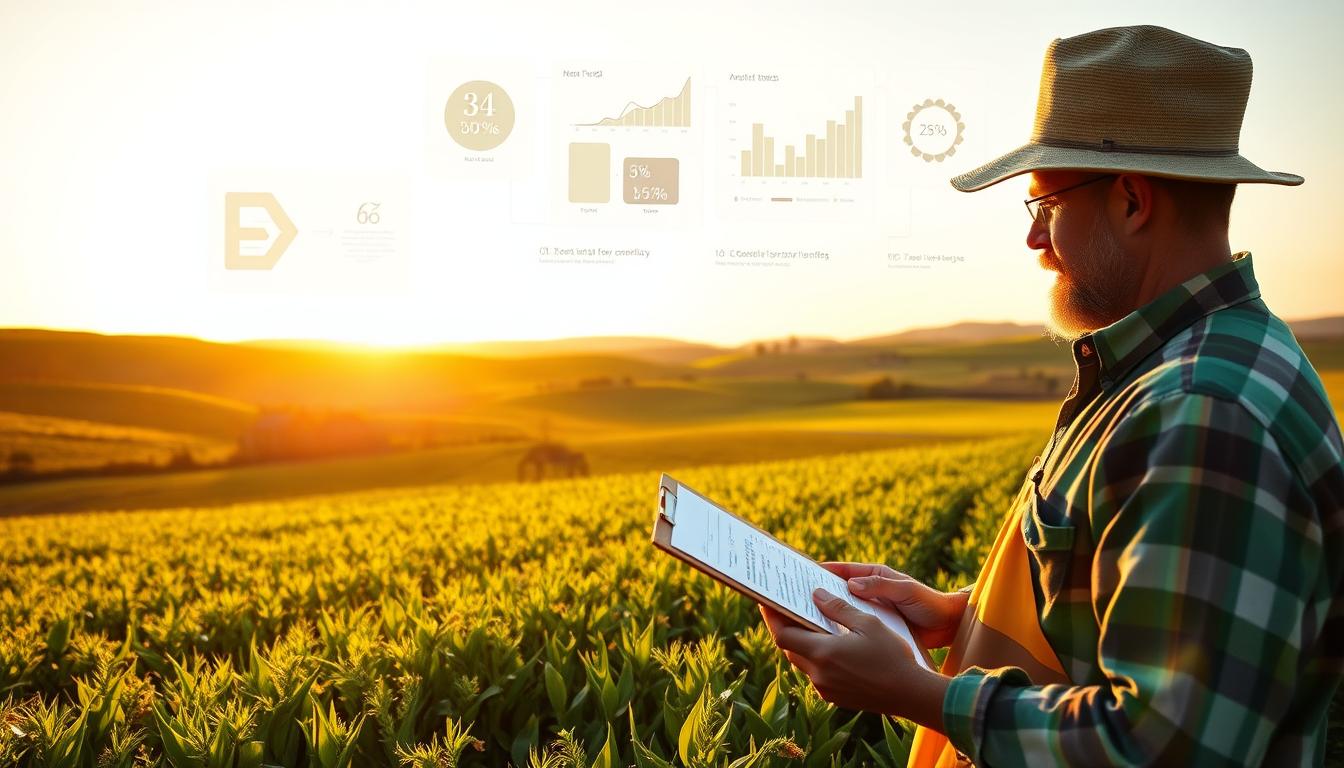Making informed decisions is crucial in farm management, where the right choices can significantly impact productivity and profitability. By understanding and applying economic principles, farmers and agricultural professionals can optimize their agricultural practices.
The integration of agricultural economics into decision-making processes enables farmers to better navigate the complexities of the agricultural market. This includes understanding supply and demand, managing resources efficiently, and making strategic decisions about crop selection and livestock management.
Key Takeaways
- Understanding economic principles can improve farm management decisions.
- Agricultural economics plays a crucial role in optimizing farm productivity.
- Efficient decision-making is key to enhancing profitability in agriculture.
- Applying economic principles helps in navigating agricultural market complexities.
- Strategic planning is essential for successful farm management.
The Intersection of Economics and Agriculture
The application of economic principles in agriculture has a rich history that has significantly shaped modern farming practices. Economics has been instrumental in helping farmers make informed decisions about resource allocation, production, and marketing.
Historical Evolution of Agricultural Economics
Agricultural economics has undergone significant transformations, from simple subsistence farming to complex commercial operations.
From Subsistence to Commercial Agriculture
The shift from subsistence to commercial agriculture marked a significant turning point in the history of agricultural economics. As markets expanded and trade increased, farmers began to focus on producing surplus crops for sale, rather than just for their own consumption.
Development of Modern Agricultural Economic Theory
The development of modern agricultural economic theory has provided farmers with sophisticated tools for decision-making. Theories such as comparative advantage and opportunity cost have become essential in optimizing farm management.
Why Economic Thinking Matters for Modern Farmers
Economic thinking is crucial for modern farmers as it enables them to navigate complex market dynamics and make informed decisions about their operations.
Competitive Advantage in Today’s Agricultural Markets
In today’s competitive agricultural markets, farmers must leverage economic thinking to gain a competitive edge. This involves understanding market trends, managing costs, and optimizing production.
Economic Literacy as a Farm Management Tool
Economic literacy is a vital tool for farm management, enabling farmers to analyze financial data, assess risks, and make strategic decisions. By applying economic principles, farmers can improve their profitability and sustainability.
Economic Principles Applied to Agricultural Decision-Making
The application of economic principles to agricultural practices is crucial for optimizing farm operations and maximizing profitability. By understanding and leveraging these principles, farmers can make more informed decisions that impact their bottom line.
Supply and Demand Dynamics in Agricultural Markets
The forces of supply and demand play a pivotal role in determining the prices of agricultural products. Understanding these dynamics is essential for farmers to make informed production decisions.
Price Determination for Farm Products
Farmers must consider various factors, including production costs, market demand, and global supply trends, when determining the prices of their products. Effective pricing strategies can significantly impact a farm’s profitability.
Market Equilibrium and Disequilibrium Effects
Market equilibrium occurs when the supply of a product meets the demand. However, disequilibrium can happen due to factors like weather conditions or changes in consumer preferences, leading to price fluctuations.
Opportunity Cost in Farm Resource Allocation
Opportunity cost is a fundamental economic concept that refers to the value of the next best alternative given up when a choice is made. In agriculture, understanding opportunity costs can help farmers allocate resources more efficiently.
Marginal Analysis for Agricultural Production
Marginal analysis involves examining the additional costs and benefits of a decision. In agricultural production, this can help farmers determine the optimal level of inputs, such as fertilizers or labor, to maximize profits.
Determining Optimal Input Levels
By applying marginal analysis, farmers can identify the point at which the cost of an additional unit of input equals the revenue generated by that unit, thus optimizing their input levels.
Profit Maximization Strategies
Profit maximization is a key goal for farmers. Strategies such as improving efficiency, reducing waste, and adopting new technologies can help achieve this goal. Embracing innovation is crucial in today’s competitive agricultural landscape.
Optimizing Land Use Decisions Through Economic Analysis
Optimizing land use through economic analysis is essential for modern farming practices. By applying economic principles, farmers can make informed decisions that enhance productivity and profitability while ensuring sustainability.
Land Valuation Techniques
Accurate land valuation is critical for making informed land use decisions. Two primary methods are used: income capitalization approaches and comparative market analysis.
Income Capitalization Approaches
The income capitalization approach values land based on its potential to generate income. This method considers factors like crop yields, commodity prices, and production costs to estimate the land’s value.
Comparative Market Analysis for Agricultural Land
Comparative market analysis involves evaluating recent sales of similar agricultural lands to determine a fair market value. This approach helps farmers understand the market and make competitive decisions.
Crop Rotation Economics
Crop rotation is a vital practice that affects soil health, pest management, and overall farm productivity. Economically, it can reduce the need for external inputs like fertilizers and pesticides, thus saving costs.
Conservation vs. Production Trade-offs
Farmers often face decisions that involve trade-offs between conservation practices and production levels. Understanding the economic implications of these choices is crucial.
Economic Benefits of Soil Conservation
Soil conservation practices, such as no-till farming and cover cropping, can have significant economic benefits by reducing erosion and improving soil health.
Valuing Ecosystem Services in Farm Planning
Ecosystem services like pollination, pest control, and carbon sequestration have economic value. Incorporating these values into farm planning can lead to more sustainable and profitable farming practices.
Investment Analysis for Farm Equipment and Technology
Farmers face critical decisions when investing in new equipment and technology, requiring a thorough economic analysis. The right investments can significantly enhance farm productivity and profitability, while poor decisions can lead to financial strain.
Capital Budgeting for Agricultural Investments
Capital budgeting is a crucial process for evaluating farm equipment and technology investments. It involves assessing the potential returns on investment through techniques such as Net Present Value (NPV) analysis and Internal Rate of Return (IRR) calculations.
Net Present Value Analysis for Farm Purchases
NPV analysis helps farmers determine the present value of future cash flows generated by an investment, providing a clear picture of its potential profitability. For instance, a farmer considering the purchase of a new tractor can use NPV to compare the present value of future savings or revenue increases against the initial investment cost.
Internal Rate of Return Calculations
IRR calculations offer another perspective by estimating the rate at which an investment breaks even. This is particularly useful for comparing different investment opportunities with varying costs and expected returns.
Cost-Benefit Analysis of Precision Agriculture Technologies
Precision agriculture technologies, such as GPS-guided equipment and drones, offer significant potential for improving farm efficiency and reducing costs. A thorough cost-benefit analysis is essential to determine whether the adoption of these technologies is economically justified.
For example, a cost-benefit analysis might reveal that while the initial investment in precision agriculture technology is high, the long-term savings on inputs like seeds and fertilizers, combined with potential yield increases, make it a worthwhile investment.
Financing Options and Economic Implications
Farmers have various financing options for equipment and technology, including leasing, purchasing, and loans. Each option has its economic implications, which must be carefully considered.
Lease vs. Purchase Decisions
Leasing equipment can provide flexibility and reduce upfront costs, but it may result in higher long-term expenses. Purchasing, on the other hand, requires a significant initial outlay but can offer long-term savings.
Tax Considerations in Equipment Acquisition
Tax considerations play a crucial role in equipment acquisition decisions. Farmers should be aware of potential tax deductions and credits available for equipment purchases or leases, which can significantly impact the overall cost of the investment.
| Financing Option | Initial Cost | Long-term Cost | Tax Benefits |
|---|---|---|---|
| Leasing | Low | High | Limited |
| Purchasing | High | Low | Significant |
Risk Management Strategies Based on Economic Principles
Understanding and managing risk is essential for farmers to make informed decisions and achieve long-term success. Agricultural operations are inherently risky due to factors like weather variability, market fluctuations, and production uncertainties. Applying economic principles to risk management can help farmers mitigate these risks and stabilize their income.
Agricultural Insurance Economics
Agricultural insurance is a critical tool for managing risk. It provides financial protection against crop failures, livestock deaths, and other unforeseen events. Crop insurance, in particular, has become a vital component of farm risk management strategies.
Crop Insurance Cost-Benefit Analysis
Farmers must conduct a thorough cost-benefit analysis when considering crop insurance. This involves evaluating the premiums paid against the potential payouts in case of crop failure. Factors such as historical yield data, weather patterns, and market conditions play a crucial role in this analysis.
Revenue Protection vs. Yield Protection
There are different types of crop insurance policies, including revenue protection and yield protection. Revenue protection policies cover losses due to both yield reductions and price declines, while yield protection policies focus solely on yield losses. Farmers need to choose the policy that best aligns with their risk exposure and financial situation.
Diversification as Risk Mitigation
Diversification is another effective risk management strategy. By diversifying their operations, farmers can reduce their dependence on a single crop or market, thereby spreading out the risk.
Enterprise Diversification Economics
Enterprise diversification involves expanding into different agricultural enterprises, such as switching from a single crop to multiple crops or integrating livestock production. This strategy can help stabilize farm income by reducing reliance on a single revenue source.
Geographic Diversification Strategies
Geographic diversification involves operating in multiple locations to mitigate risks associated with localized weather events or market conditions. While this strategy can be effective, it also involves significant logistical and management challenges.
Futures and Options Markets for Price Risk Management
Futures and options markets provide farmers with tools to manage price risk. By using these financial instruments, farmers can lock in prices for their products, protecting themselves against adverse price movements.
Hedging Strategies for US Commodity Producers
Hedging involves taking a position in the futures market that is opposite to the position held in the physical market. For example, a farmer who is growing corn can sell corn futures to hedge against a potential decline in corn prices.
Basis Risk Management Techniques
Basis risk refers to the difference between the local cash price and the futures price. Managing basis risk is crucial for effective hedging. Farmers need to understand the factors that influence basis risk and use appropriate strategies to mitigate it.
Labor Economics in Agricultural Operations
The application of labor economics principles can significantly enhance agricultural productivity. Labor economics plays a crucial role in optimizing the use of labor resources in agricultural operations, directly impacting the bottom line of farming businesses.

Optimizing Workforce Allocation
Effective workforce allocation is essential for maximizing efficiency in agricultural operations. By understanding labor economics, farmers can make informed decisions about how to distribute their workforce across different tasks and crops. This involves analyzing the marginal product of labor to ensure that each worker is utilized to their fullest potential.
Seasonal Labor Considerations
Seasonal fluctuations in labor demand pose a significant challenge for agricultural businesses. The H-2A program, which allows for the temporary employment of foreign workers, can be a vital resource during peak seasons. Understanding the economics of this program is crucial for farmers to navigate the complexities of seasonal labor.
H-2A Program Economics for US Farms
The H-2A program offers a legal pathway for agricultural employers to bring in foreign workers to meet seasonal labor needs. However, the program comes with specific economic implications, including costs associated with housing, transportation, and wages for the workers. Farmers must weigh these costs against the benefits of hiring through the H-2A program.
Labor Cost Forecasting and Budgeting
Accurate labor cost forecasting is vital for agricultural businesses to budget effectively. By analyzing historical labor costs and understanding the factors that influence these costs, farmers can better predict future expenses. This enables them to make more informed decisions about production and resource allocation.
Automation Economics: When to Replace Labor with Technology
The increasing availability of automation technologies in agriculture raises important questions about when to replace labor with machinery. While automation can offer significant productivity gains, it also involves substantial upfront costs. Farmers must conduct thorough economic analyses to determine the break-even point for automation investments.
Break-even Analysis for Automation Investments
Break-even analysis is a critical tool for evaluating the economic viability of automation investments. By comparing the costs of automation with the expected benefits, farmers can determine when such investments will pay off. This analysis is essential for making informed decisions about adopting new technologies.
Long-term Labor Market Trends in US Agriculture
Understanding long-term labor market trends is crucial for agricultural businesses to plan for the future. Shifts in labor supply and demand, changes in immigration policies, and advancements in technology all impact the agricultural labor market. Farmers who stay informed about these trends can better position themselves for success.
Market Analysis and Price Forecasting for Agricultural Products
Market analysis and price forecasting are essential tools for agricultural businesses to navigate the complexities of the market. By understanding market dynamics, farmers can make informed decisions that impact their profitability and sustainability.
Understanding Market Structures in Agriculture
Agricultural markets operate under various structures that influence how products are priced and distributed. Understanding these structures is crucial for effective market analysis.
Perfect Competition vs. Oligopsony in US Agricultural Markets
The US agricultural market often exhibits characteristics of perfect competition, where many buyers and sellers interact. However, certain sectors, like livestock, may experience oligopsony, where a few large buyers dominate the market.
Value Chain Analysis for Farm Products
Value chain analysis helps farmers understand the various stages their products go through from production to consumption. This analysis can identify areas for cost reduction and efficiency improvements.
Price Elasticity and Its Impact on Farm Revenue
Price elasticity measures how responsive the quantity demanded of a product is to changes in its price. Understanding price elasticity is vital for farmers to predict how price changes will affect their revenue.
Techniques for Agricultural Price Forecasting
Accurate price forecasting is critical for farmers to make informed decisions. Several techniques are employed, including the use of USDA reports and market intelligence, as well as technical and fundamental analysis methods.
USDA Reports and Market Intelligence
The USDA provides valuable reports and data that help farmers and agricultural businesses understand market trends and make informed decisions.
Technical and Fundamental Analysis Methods
Technical analysis involves studying past market data to predict future price movements. Fundamental analysis, on the other hand, examines factors like supply and demand, weather, and economic indicators to forecast prices.
By combining these techniques and understanding market structures, farmers can better navigate the complexities of agricultural markets and make more informed decisions.
Economic Decision-Making for Sustainable Agriculture
Sustainable agriculture requires a delicate balance between economic viability and environmental stewardship. As farmers navigate the complexities of modern agriculture, they must make informed economic decisions that support long-term sustainability.
Valuing Ecosystem Services
Ecosystem services, such as pollination, soil health, and water filtration, are crucial for agricultural productivity. Valuing these services is essential for making informed economic decisions.
Carbon Markets and Credit Opportunities
Carbon markets offer farmers the opportunity to generate additional revenue by sequestering carbon through practices like regenerative agriculture. This not only benefits the environment but also enhances farm profitability.
Water Quality Trading Programs
Water quality trading programs allow farmers to sell credits for reducing nutrient runoff or implementing conservation practices, providing another economic incentive for sustainable practices.
Economics of Organic vs. Conventional Production
The choice between organic and conventional production methods involves a complex economic analysis. Organic farming often commands a price premium but may involve higher production costs and lower yields.
| Production Method | Average Yield | Price Premium | Production Cost |
|---|---|---|---|
| Organic | Lower | Higher | Higher |
| Conventional | Higher | Lower | Lower |
Long-term Sustainability and Profitability Balance
Achieving a balance between long-term sustainability and profitability is critical. Practices like regenerative agriculture can enhance soil health, biodiversity, and ecosystem services, contributing to both sustainability and economic viability.
Regenerative Agriculture Economics
Regenerative agriculture focuses on regenerating soil health, improving biodiversity, and enhancing ecosystem services. This approach can lead to improved profitability through reduced input costs and premium prices for regeneratively grown products.
Climate Change Adaptation Investments
Investing in climate change adaptation measures, such as drought-resistant crops and irrigation systems, can help farmers mitigate the economic impacts of climate change.

Government Policies and Their Economic Impact on Agricultural Decisions
Farmers and agricultural businesses must navigate a complex landscape of government policies that impact their economic choices. These policies can significantly influence production decisions, resource allocation, and overall profitability in the agricultural sector.
Farm Subsidies and Their Influence on Production Choices
Farm subsidies are a crucial aspect of agricultural policy, providing financial support to farmers and influencing their production decisions. The US government offers various subsidy programs through the Farm Bill, which can affect crop choices and production levels.
US Farm Bill Programs and Economic Decision-Making
The Farm Bill is a comprehensive piece of legislation that encompasses a wide range of agricultural and food programs. It includes commodity programs, crop insurance, and conservation initiatives, all of which impact farmers’ economic decisions.
Payment Optimization Strategies
Farmers can employ various strategies to optimize their subsidy payments, such as diversifying crops, participating in conservation programs, and utilizing crop insurance effectively. These strategies can help maximize financial benefits while managing risk.
Environmental Regulations and Compliance Economics
Environmental regulations play a vital role in shaping agricultural practices, with compliance economics being a critical consideration for farmers. Regulations related to water quality, soil conservation, and biodiversity can impact production costs and decision-making.
International Trade Policies and Market Access
International trade policies significantly affect agricultural markets, influencing prices, demand, and market access for farmers. Trade agreements and tariffs can either open up new opportunities or create challenges for agricultural exports.
Tariff Impacts on US Agricultural Exports
Tariffs imposed on US agricultural exports can make products more expensive for foreign buyers, potentially reducing demand. This can have significant economic implications for farmers who rely on international markets.
Trade Agreement Benefits and Challenges
Trade agreements can provide benefits such as increased market access and reduced tariffs, but they also present challenges, including increased competition and potential regulatory hurdles. Farmers must navigate these complexities to capitalize on new opportunities.
Understanding the economic impact of government policies is essential for farmers to make informed decisions. By staying informed about policy changes and leveraging available resources, agricultural businesses can optimize their operations and improve profitability.
Data-Driven Economic Analysis Tools for Modern Farmers
Data-driven economic analysis is revolutionizing the way farmers manage their operations. By leveraging advanced tools and technologies, farmers can now make more informed decisions that enhance profitability and sustainability.
Farm Management Software for Economic Decision Support
Farm management software plays a crucial role in economic decision-making for farmers. These tools provide comprehensive solutions for managing various aspects of farm operations.
Enterprise Budgeting Applications
Enterprise budgeting applications help farmers create detailed financial plans for different segments of their operations. This enables them to identify areas of inefficiency and optimize resource allocation.
Scenario Analysis Tools
Scenario analysis tools allow farmers to simulate different scenarios, such as changes in market conditions or weather patterns, to anticipate potential outcomes and adjust their strategies accordingly.
Big Data Applications in Agricultural Economics
The use of big data in agricultural economics has opened up new avenues for analysis and decision-making. By analyzing large datasets, farmers can gain insights into trends and patterns that inform their economic decisions.
Predictive Analytics for Optimizing Farm Profitability
Predictive analytics is a powerful tool for optimizing farm profitability. It involves using statistical models to forecast future outcomes based on historical data.
Yield Forecasting and Revenue Projection
Yield forecasting and revenue projection enable farmers to anticipate their future income and make informed decisions about investments and resource allocation.
Input Optimization Models
Input optimization models help farmers determine the most cost-effective combination of inputs, such as seeds, fertilizers, and labor, to maximize their returns.
By embracing data-driven economic analysis tools, farmers can significantly enhance their decision-making processes, leading to improved profitability and sustainability.
Conclusion: Integrating Economic Thinking into Daily Farm Management
Integrating economic thinking into daily farm management is crucial for making informed decisions that drive productivity and profitability. By applying economic principles, farmers can optimize resource allocation, manage risks, and improve their overall farm performance.
Economic thinking enables farmers to analyze market trends, understand supply and demand dynamics, and make data-driven decisions. This approach helps in identifying opportunities for cost reduction, improving efficiency, and enhancing profitability.
Effective farm management involves leveraging economic analysis to navigate the complexities of agricultural production. By adopting economic thinking, farmers can better manage resources, mitigate risks, and achieve their business goals. As the agricultural sector continues to evolve, the integration of economic principles will remain essential for sustainable and profitable farming practices.
By embracing economic decision-making, farmers can ensure long-term success and contribute to a more efficient and productive agricultural industry.

